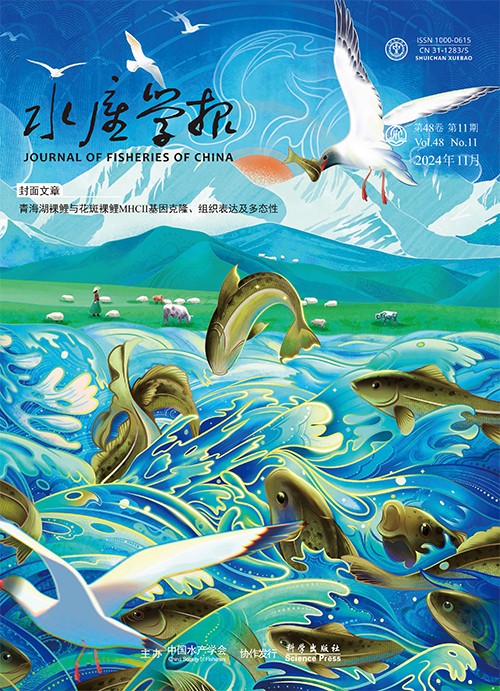鄱阳湖鼻蝽耳石的两种微化学模式
Q4 Environmental Science
引用次数: 6
摘要
为确定鄱阳湖内是否存在无源河口细尾凤尾鱼,采用电子探针微量分析仪(EPMA)对在鄱阳湖星子区采集的2条鱼耳石进行了Sr和Ca元素的微量化学分析。样线分析结果显示,上颌骨较短个体(PYCB02)的耳石Sr∶Ca×1 000比值始终较低(1.66±0.54),表明其一生都生活在淡水生境中。另一个较长的上毛个体(PYCE05) Sr/Ca比值分布复杂,可分为1.82±0.50、5.79±0.91和4.14±0.88三个阶段,表明其在不同的生活史阶段不仅经历了淡水环境,还经历了海水和咸淡水环境。所有这些差异都可以通过EPMA的x射线作图分析结果得到很好的证实。PYCB02的整个耳石从核心到最外层呈均匀的淡蓝色(低Sr水平)。PYCE05的耳石呈多色模式。在与偏蓝的中心区域相邻的外围区域有偏绿(中等锶水平)、偏黄(中等锶水平)甚至偏红(高锶水平)。两种不同的微化学模式的样线和测图分析结果,首次客观地证实了鄱阳湖中鼻蝽的居住形态和溯河形态共存,表明鼻蝽仍有可能溯河洄游到距长江口约800 km的鄱阳湖产卵。上述微化学模式将为更有效地评价和保护鄱阳湖盘尾藻资源,以及合理规划和指导未来鄱阳湖生态经济发展提供重要信息。本文章由计算机程序翻译,如有差异,请以英文原文为准。
Two microchemistry patterns in otoliths of Coilia nasus from Poyang Lake, China.
To confirm whether there is anadromous estuarine tapertail anchovy Coilia nasus now in Poyang Lake,an electron probe microanalyzer(EPMA)was applied to analyze the element Sr and Ca microchemistry patterns in otoliths of two individuals collected from Xingzi area of the lake.Results of line transect analysis showed that the ratios of Sr∶ Ca×1 000 in the otolith of the individual with a shorter supramaxilla(PYCB02)were consistently low(1.66±0.54),indicating that it experienced in freshwater habitat during its whole life history.Another individual with a longer supramaxilla(PYCE05)had a complex Sr/Ca ratio pattern which can be divided into three phases(1.82±0.50,5.79±0.91,and 4.14±0.88),suggesting it experienced not only the freshwater,but also the seawater and brackish water during different stages in its life history.All these differences could be well confirmed by the results of X-ray mapping analysis of EPMA.The whole otolith of PYCB02 presented a uniform bluish pattern(low Sr level)from the core to the outermost regions.In contrast,the otolith of PYCE05 showed a multi-color pattern.There were greenish(moderate Sr level),yellowish(moderate Sr level),or even reddish(high Sr level)in outer regions adjacent to the bluish central regions.Results of the two different microchemistry patterns obtained by both the line transect and mapping analyses confirmed objectively,for the first time,the coexistence of resident and anadromous forms of Coilia nasus in Poyang Lake and suggested that Coilia nasus is still possible to migrate anadromously for spawning into Poyang Lake,which is about 800 km away from the river mouth of Yangtze River.These aforementioned microchemistry patterns will provide important information not only to more effectively evaluate and protect the resources of Coilia nasus,but also to rationally plan and guide future ecological economic development in Poyang Lake.
求助全文
通过发布文献求助,成功后即可免费获取论文全文。
去求助
来源期刊

水产学报
Environmental Science-Management, Monitoring, Policy and Law
CiteScore
1.40
自引率
0.00%
发文量
5213
期刊介绍:
"Fisheries of" mainly reflects the results of scientific research and development of the direction of aquaculture for domestic and foreign academic exchanges Fisheries Service. Mainly basic research published in Fisheries, aquaculture and proliferation of fishing waters environmental protection, preservation of aquatic products processing and utilization, fishing equipment, and other aspects of mechanical papers, research briefings and reviewed.
 求助内容:
求助内容: 应助结果提醒方式:
应助结果提醒方式:


